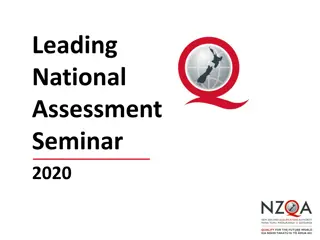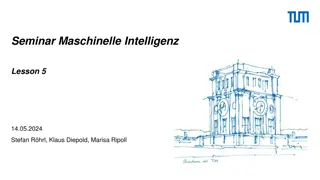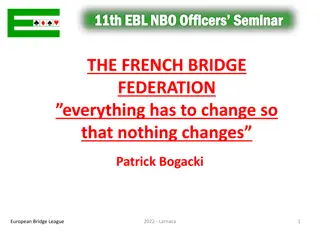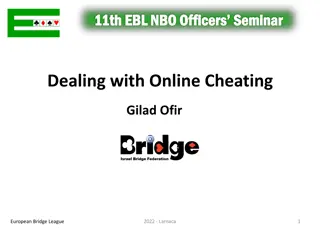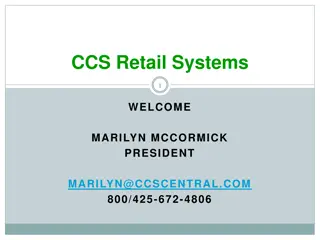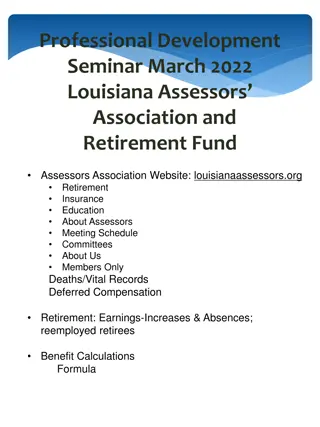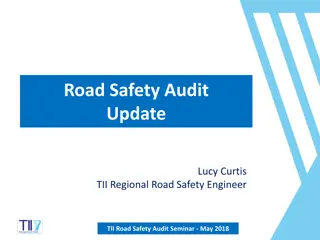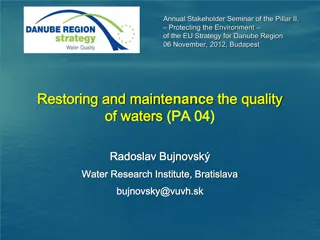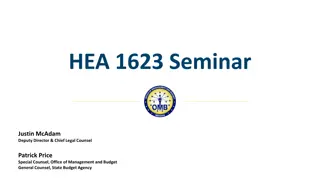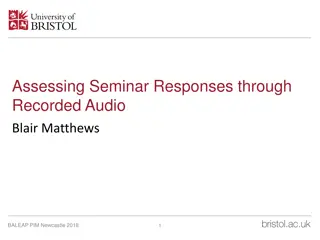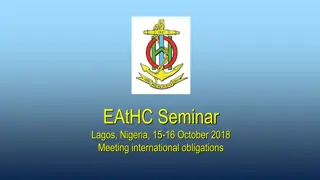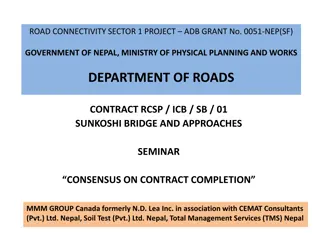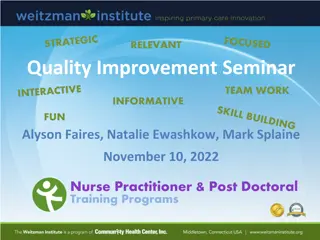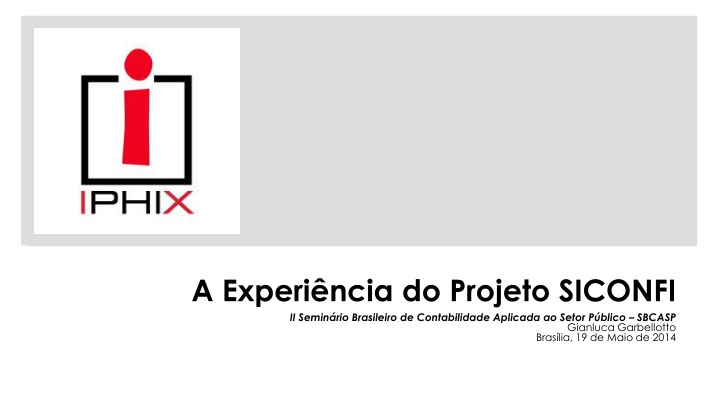
Project SICONFI II Seminar Experience
This presentation covers the experience and insights shared at the SICONFI II Seminar on Applied Public Sector Accounting. Topics include an introduction to XBRL and the Global Ledger, value of standards, infrastructure alignment, XML usage, and the impact of standardizing business reporting through XBRL. The catalyst for standardizing business reporting across international public companies is explored, emphasizing the need for structured financial data.
Download Presentation

Please find below an Image/Link to download the presentation.
The content on the website is provided AS IS for your information and personal use only. It may not be sold, licensed, or shared on other websites without obtaining consent from the author. If you encounter any issues during the download, it is possible that the publisher has removed the file from their server.
You are allowed to download the files provided on this website for personal or commercial use, subject to the condition that they are used lawfully. All files are the property of their respective owners.
The content on the website is provided AS IS for your information and personal use only. It may not be sold, licensed, or shared on other websites without obtaining consent from the author.
E N D
Presentation Transcript
A Experincia do Projeto SICONFI II Semin rio Brasileiro de Contabilidade Aplicada ao Setor P blico SBCASP Gianluca Garbellotto Bras lia, 19 de Maio de 2014
Agenda Introdu o ao XBRL e XBRL Global Ledger Introdu o (r pida) ao Projeto SICONFI - Mais depois O DATA Act em os EUA
Introduo ao XBRL e XBRL Global Ledger
O Valor dos Padres It's About Agreement! It's about (sufficient) It's about (sufficient) understanding. understanding.
Combine a Infra-Estrutura com o Padro Correspondente 1. 2. 3. 4. 5. 6. 7. 8. 9. RJ 11 40 x 8.5 x 8 UPC HTML / SOAP / Web Services 4 8.5 RJ 45 Rosettanet, MDDL, XBRL 220V, 50Hz XBRL 1. Rail Road 2. Electricity 3. Telephone 4. Shipping 5. Product 6. Networking 7. Internet 8. 9. Information Business data transparency
XML Family XML Rules for text and angle brackets XML Schema Validation tool for XML Namespaces Same words, different schemas XLink Ties XML to internal and external references XSL and CSS XML with Style
XML Without Agreement XML is self-defining? Sure, this looks simple:
is just SYNTAX But how self-defining is this? To a computer (XML parser), they are the same The tags (element names) provide no semantic knowledge to the program
Catalyst: Standardizing Business Reporting Today over 65,000 International public companies release financial results half yearly and quarterly But the contents are not organized. The data must be reentered into computer applications for interpretation. What if financial documents included both content ( 75,453) and structure ( 75,453=net income for Q1/2011)? ENTER XBRL
Catalyst: Standardize Management Reporting Multiple departmental Excel spreadsheets Consolidated spreadsheets for management Transactional data System A SQL Senior System B Management SQL System C 2000 elements = 6500 spreadsheets (this is not a typo)
Some Problems with Todays Model Information goes in one direction Information has no shared context Analysis of the information is conducted via macros that are embedded within the applications and are not reusable by others . Information labels are inconsistent from one application to another Information is not independently validated Information is not connected to other related resources across applications Application-Dependent Information Is
XBRL: Three Primary Components Multi-dimensional Specification Optimized for business reporting Syntax and semantics of taxonomies and instances XML, Namespaces, XML Schema, XLink Discoverable Taxonomies Reusable information US GAAP, IFRS, XBRL GL, SBR and others Extensible More detail Shared understanding Community Accounting profession, developers, regulators, users, financial services, data aggregators 800+ XML describes, XBRL defines
Where is it relevant? The BRSC Internal Business Reporting External Business Reporting Investment, Lending, Regulation Business Operations Economic Policymaking Processes Accounting Software ERP systems UBL Rosettanet ACORD MISMO FPML Others SCOA/Trial balance AP/AR Ledgers General Ledger Fixed Assets, Inventory Documents/Entries Parties, entities KPIs financial and not Others US GAAP IFRS SBR GRI G3 Statutory MD&A Crating the seamless interface
How Is It Used? Transparency and greater analytical insight and capabilities SEC in the US and similar global regulatory programs Reduction of the reporting burden for businesses SBR programs Efficient collection and dissemination of government information SICONFI in Brazil, Open Government initiatives, such as the DATA Act in the US Automation, efficiency and cost reduction in data related corporate processes
XBRL is More Than Just Tagging Business Information Multi-dimensional business and financial data representations Flexibility of business reporting vocabularies (i.e. taxonomies) Mathematical relationships between concepts Flexibility about how to present information to users
XBRL FR and XBRL GL XBRL for Financial Reporting (XBRL FR) or, more generally, XBRL for End Reporting (XBRL ER) Represents summarized reports Loose data model composed by data points (fields in reports) linked by arcs (linkbases) and referencing context and units information defined in separate XML fragments within the XBRL instance document XBRL Global Ledger (XBRL GL) Represents detailed, transactional data and its mappings to data points in XBRL FR taxonomies Structured data model (XML Schema) similar to structure of information stored in accounting/ERP software Easy to map to Enables greater control on data quality in end reports
The Standards-Driven Paradigm Shift No need to replace or modify existing systems Software tools, lessons learned, business processes and knowledge bases are reusable in different projects and domains Application-independent data accuracy and consistency and process automation Data transparency Minimally invasive, low cost technology
How XBRL Is Used in SICONFI Source/Detailed Data Mappings Summarized Reports DCASP MSC RGF COC (Operations) RREO DEFP Outros PCASP COC (Reports) XBRL GL XBRL GL XBRL FR
How XBRL Is Used in SICONFI Standard Business Reporting (SBR) Taxonomy Architecture Definitional Taxonomy Common Dictionary Define the concept once Information Classification B Information Classification A A.1 B.1 A.2 B.2 Address Wages & Salaries re-use on many reports Reporting Taxonomies Agency X Agency Y Agency Report X.1 Report Y.1 Report X.2 Report Y.2
The Digital Accountability and Transparency Act (DATA) in the USA
Overview It s all about open data The transformation: Government-wide data standards; comprehensive publication requirements The scope: Federal financial, assistance, procurement, and performance reporting The driver: Legislative mandate
Current Landscape Financial reporting: Agencies to Treasury Payment requests: Agencies to Treasury Budget planning and actions: Agencies to OMB Assistance: Agencies to Commerce, GSA Procurement: Agencies to GSA Grants: Awardees to agencies Contracts: Awardees to agencies, GSA Subawards: Prime awardees to OMB GPRA: Agencies to Congress, OMB
Current Shortcomings Information not available. The public, Congress, Treasury and OMB, agency leaders, inspectors general, and even program managers don t have the data they need. Information not accessible. Information is frequently available only as documents or summaries. Information not interoperable. Government-wide data fields, even for basic concepts, don t exist. Formats differ. There is no way to link spending and performance.
DATA: the Basics Treasury and OMB Agencies Establish government-wide identifiers Apply the standards wherever applicable Establish government-wide formats Data quality checks Awardees Publish grants, contracts, and internal spending on existing USASpending.gov portal Standardized reporting imposed by agencies Recovery Board Pilot program for consolidated reporting by grantees and contractors Accountability platform to Treasury
DATA: Desired Impact Public Accountability. Citizens have access to accurate, complete, searchable data on government spending and performance Better Management. Congress, Treasury, OMB, agency leaders, inspectors general, program managers utilize dashboards and analytics Automated Compliance. Grantees and contractors report to agencies without strain; agencies automate reports to Treasury, OMB, Commerce, GSA, Congress
Implementation Treasury and OMB to issue guidance 1 year after passage Agencies to begin using data standards 2 years later Grant/contract reporting consolidation pilot starts 1 year after passage and lasts 2 years
Project SICONFI Helped Significant XBRL implementation in the G2G space in a major economy Government SCOA used in both countries Use of XBRL GL in conjunction with XBRL reports to Simplify implementation for Government entities Enhance data quality through pre-defined mappings and the ability to push validation rules at the USSGL (MSC) and transactional level SBR taxonomy architecture
OBRIGADO! Your Speaker: Gianluca Garbellotto IPHIX, CEO XBRL Best Practices Board, member XBRL Global Ledger Working Group, Chair gg@iphix.net Twitter: @iphixbrl

